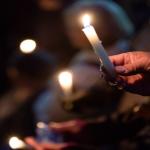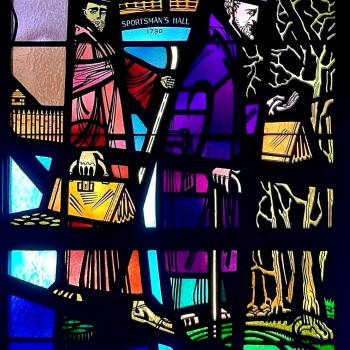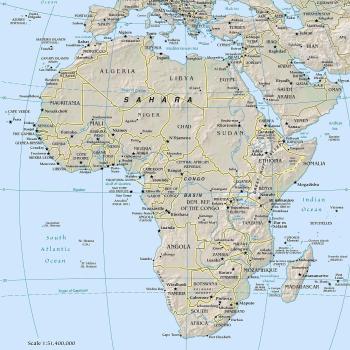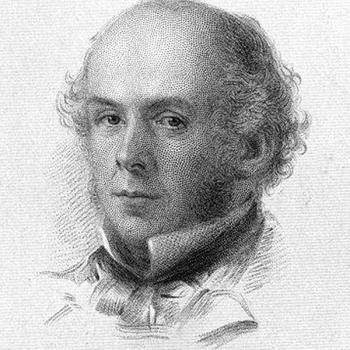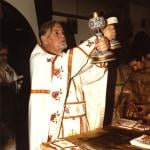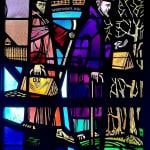Somewhere over the past twenty years or so, a once-key concept in American history, and American religious history, simply vanished. Vanished to the extent that anyone referring to the concept today needs to provide some serious explanation, possibly backed up by flash cards. To the best of my knowledge, nobody has yet mapped the disappearance, or even cited the mystery.
I am referring to the social and political categories that were once known as white ethnics. Before anyone raises the objection, in a sense everyone is “ethnic” in the sense of having some ethnic identity or background, which may play a greater or lesser role in defining their consciousness. In American history, however, the term “white ethnics” usually refers to immigrant communities distinct from the older and mainly Protestant Anglo-Celtic and German groups who were established by the early national period. Those included the waves of nineteenth century Catholic Irish migrants, and also the populations who flooded into the US in the last great immigration wave at the turn of the twentieth century. These mainly came from southern and eastern Europe – Italians, Poles, Hungarians, Ukrainians, Lithuanians, Serbians, Croats, and many smaller groups. Through the twentieth century, these “ethnics” dominated American cities and industrial communities, and comprised the bulk of the working class. They were largely Catholic, but some were Orthodox, or members of the Uniate churches. Depending on definition, the white ethnic category often, but not always, included Jews.
Of course, the various groups were separated in countless ways, but what united them was common hostility or coldness to old stock Whites – to WASPs, White, Anglo-Saxon Protestants. That term was coined in 1957, and popularized by Digby Baltzell in his 1964 book The Protestant Establishment. Conflict between WASPs and ethnics emerged repeatedly in political life. One popular interpretation of the McCarthy era portrayed it as the revenge of rising ethnics, Catholics and Jews, against old WASP elites, who found the perfect symbol in Alger Hiss. In 1970, Harper’s published Peter Schrag’s much discussed article on “The Decline of the WASP,” which became the basis of his 1971 book of the same name. WASPs, it seemed, were giving way – and not, as we may think today, to a multi-ethnic multi-cultural nation, but rather to the white ethnics. Significantly, the foreign born population of the USA reached a historic low precisely in 1970, before beginning its mighty upward push in the latter years of the century.
When traditional industries boomed, so did the workers that depended on them, and so did the unions whose ranks they filled. Politically, the working class and white ethnics were an essential component of the New Deal coalition that dominated US life from 1932 through 1980. The large-scale defection of white ethnics to Nixon caused a soul searching rather like the effects of the 2016 Trump election. That earlier wave of concern spawned a major outpouring of books, learned essays, and media pieces from the late 1960s through the 1970s, with notable contributions by Fr. Andrew Greeley and Michael Novak. Then as now, publishers presented ethnographic studies of these strange and baffling white working class areas, like Peter Binzen’s Whitetown USA (1971).
Media and academic discussion arguably reached a mass audience when All in the Family debuted in 1971, introducing Archie Bunker. Reflecting a surging interest, the 1970s would be a golden age of white ethnic cinema, with The Godfather films and The Deerhunter among the most celebrated landmarks, not to mention Saturday Night Fever. We think of so many films by Francis Ford Coppola or Martin Scorsese. I would place among the best of the bunch Steve Tesich’s 1981 film Four Friends, about young Serbian-Americans, but that’s not a standard opinion. By the way, these ethnic works are distinct from the related but specialized mythology of Mafia films and television.
Despite their very large numbers, white ethnics rarely reached the highest reaches of the political world. Although Catholics have long made up around a quarter of the US population, the US to date has had only one Catholic President, namely John F. Kennedy (Reagan was a Protestant). Joe Biden remains the only Catholic Vice-President. In 1968, Richard Nixon deliberately chose a vice presidential candidate, Spiro Agnew, because he would appeal to white ethnics, the silent majority, and to what we would today call the white working class. Agnew was Episcopalian, but he claimed to respect and follow Greek Orthodox traditions. Andrew Greeley regularly lamented the systematic exclusion of ethnics from the highest political office, and complained that as yet, no US President or Vice President had yet had a surname ending in any vowel other than E. That would change only in 2008 with Barack Obama, who was of course not a white ethnic. Of course, white ethnics had heavy representation at congressional, city, and state level.
Greeley also argued that white ethnics were the targets of perhaps the largest and most systematic unrecognized prejudice and discrimination in American society. He particularly complained about media and academic assumptions that ethnic Catholics had systematically under-performed in education and business, presumably because of the intellectual weaknesses of that faith. As he showed, “ethnics” (and especially Catholics) were often highly successful, high achievers, and profited richly from vastly expanded post-WWII opportunities in higher education.
For several decades, white ethnics were a universally recognized category, which demanded political acknowledgment and cultivation. If you are under forty – maybe under fifty – you don’t remember just how central and critical that ethnic language was, and not that far back in time.
Where did all the ethnics go? Obviously, there are still many millions of Americans who claim this kind of descent, and the great majority are proud of their heritage. But when did anyone last seriously use the language or rhetoric of white ethnicity, as apart from generalized whiteness?
Look especially at the fevered media and academic coverage of the 2016 election, which speaks so often of whites, the white working class, of declining white industrial communities, of the Rustbelt – and see how often you find the language of “ethnics.” Look at the numerous case studies of Trump-voting cities or counties, and see how rarely the journalists take the trouble to mention that this is (say) a Hungarian or Italian community, as distinct from generically white.
Many of these accounts merged the Rustbelt into an expanded concept of “Appalachia,” which historically tended to be regarded as Anglo-Celtic in racial coloring, rather than “ethnic.” But from a bi-coastal media perspective, those distinctions scarcely matter any longer. You could do a wonderful parody of those media attitudes by adapting the historic cartoon of the “New Yorker’s view of the world” – perhaps a Los Angeles-centered Field Guide to White People.
Several factors explain this shift. One, obviously, is the collapse of traditional industries since the 1970s, and the disruption or crisis of associated communities. That reinforced the crisis of solid ethnic communities, who dissipated in the face of racial change. In most big cities, those ethnic communities broke up during a process of white flight and suburbanization. Looking back at that great wave of writing about ethnics and the melting pot by Greeley and others, we can now see that it occurred in the Indian Summer of the post-war heavy industrial economy, and on the eve of a decades-long encounter with disaster.
But we are not just looking at decline and immiseration, quite the contrary. Those upwardly mobile ethnics and Catholics described by Greeley largely merged into a more homogenized social and economic elite. This transformation is neatly epitomized by the US Supreme Court, which over the past three decades has steadily increased its Catholic component, consistently at the expense of WASPs. Brett Kavanaugh’s recent confirmation means that the Supreme Court now has five Catholics and three Jews, besides Neil Gorsuch, who was raised Catholic but attends an Episcopal Church. That fact would have astounded an observer from any era of US history before the present century.
There was also a religious component to the changing role of ethnics, as the Catholic church desperately strove to reorganize parishes to respond to falling clergy numbers. Ethnic parishes were badly hit, and many were closed or consolidated. Often, these had been at the heart of distinctive ethnic communities – Polish, Italian, Irish, or other.
In party politics, we see the rapid decline of white ethnics and Catholics as a force in the Democratic Party from the 1970s onward, in the face of identity politics, gender politics, and feminism. The symbolic turning point here was the Party’s refusal to allow Pennsylvania Governor Bob Casey a major role at the 1992 Convention, on the grounds of his Catholic and pro-life views. That contributed powerfully to continuing and increasing the Reagan-era desertion of working and middle class white ethnics to the Republican Party.
Finally, there were ethnic shifts due to migration, and the steady decline of whites of any kind as a proportion of the US population. Not coincidentally, that surge of interest and attention around 1970 coincided neatly with a deep trough in immigration, as the number of foreign born Americans reached a historic low of around five percent. Today, the comparable figure approaches fourteen percent, as we project the rise of a majority-minority nation by the 2040s.
In the new politics, the former white ethnics were startled to hear themselves described chiefly in terms of whiteness. White working class people find it bewildering, and galling, to be labeled as historically “privileged” when they were struggling economically. Many, moreover, are conscious of the struggles their own ancestors had encountered against social and class oppression. The new attitude was difficult for ethnics who had suffered systematic discrimination at the hands of WASP elites.
In the Catholic church, meanwhile, it became common to distinguished between Latinos and older stock Catholics – Irish, Italians and Germans – who were regularly called “Anglos.” Again, that was much to their astonishment and horror. The emerging and evolving category of whiteness elided or ignored the long fundamental religious division.
Somewhere along the line, references to white ethnics dropped from the literature, to be replaced by the white working class, a term that lost all the older subtleties and gradations. In the context of the 2016 election and afterward, the term was commonly applied with a sense of suspicion and hostility, with those classes as the supposed bastions of bigotry, and the Trumpian faithful. This was a tragic historic shift.
As you read coverage of the midterms in coming weeks, do pay attention to the language that is used in these matters, and how these categories are described.
If a political Rip Van Winkle did return to the modern US after a sleep that had begun in, say, 1980, he would be struck by many things, but the apparent extinction of the white ethnics would be very high on the list. The new world of Whiteness would not be easy for this Rip to comprehend.
So here is an obvious follow up question. What categories or concepts do we today as absolutely fundamental and inevitable, that within twenty years or so will be equally incomprehensible? The case of the white ethnics suggests that even the labels and badges that seem so critical to self-definition today are anything but inevitable or timeless.
One important book dealing with the 1970s is Matthew Frye Jacobson, Roots Too: White Ethnic Revival in Post-Civil Rights America (Harvard Univ. Press, 2006)


